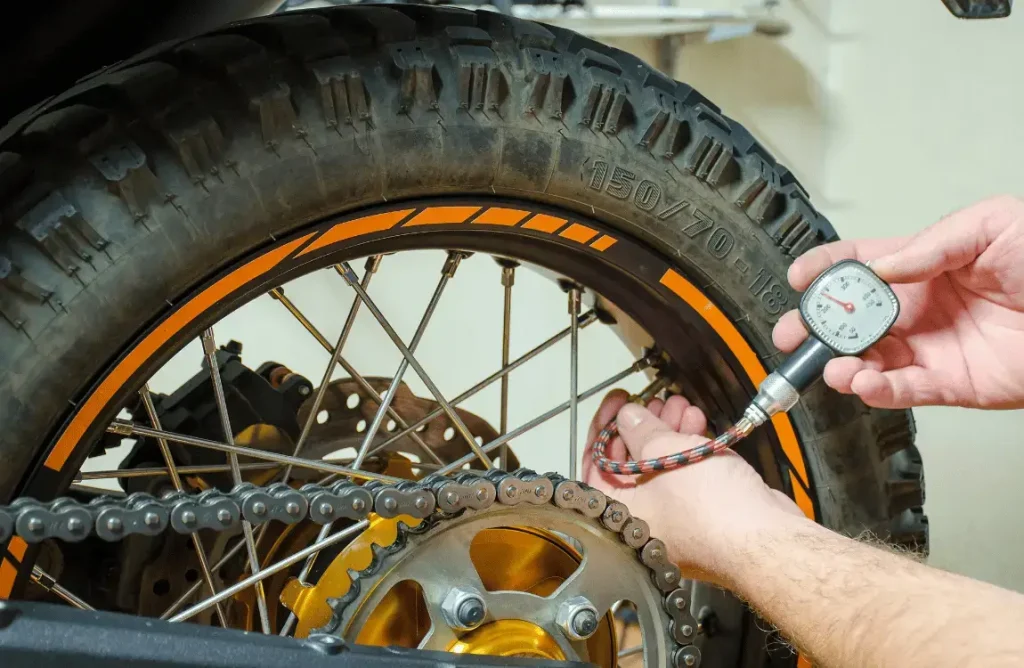To let the air out of a tire, press the tire valve stem’s center pin with a pointed object. Keep the pressure on the pin until the desired air level is reached.
Maintaining the right tire pressure is crucial for your vehicle’s performance and safety. Tires overinflated or underinflated can lead to reduced handling, higher fuel consumption, and premature wear. Occasionally, you may need to adjust your tire pressure manually, either because you’ve accidentally overinflated a tire or changes in temperature have naturally altered the air density within.
Releasing air is a simple process, but doing it correctly ensures you’re not compromising tire functionality. Whether you’re a seasoned driver or a newcomer to car maintenance, it’s important to know this basic skill. Keep a tire pressure gauge handy to avoid letting out too much air, as proper tire inflation is key to a smooth ride.

Importance Of Proper Tire Deflation
Welcome to our expert guide on How to Let Air Out of a Tire. The process may seem simple, but proper tire deflation is paramount not only for your car’s performance but also for your safety. Correct tire pressure can significantly influence how your vehicle handles on the road, fuel efficiency, and the overall lifespan of your tires. In this section, we delve into the importance of deflating your tires properly and the impact it has on both safety and durability.
Understanding The Safety Implications
Keeping tires inflated to the right pressure is crucial for vehicle safety. Over-inflated tires can result in a reduced contact area with the road, diminishing traction and increasing the likelihood of a blowout. Conversely, under-inflated tires can cause them to overheat, leading to premature wear and potential tire failure.
- Reduced Traction: Over-inflation causes tires to bulge, meaning less tire surface touches the road.
- Increased Blowout Risk: Excessive pressure makes tires more rigid and susceptible to blowouts when hitting obstacles.
- Overheating Issues: Under-inflated tires can flex excessively, generating heat that may weaken the tire structure.
Recognizing The Effects On Tire Lifespan
Maintaining the correct tire pressure is equally vital for optimizing tire lifespan. Incorrect pressure levels can lead to uneven tire wear, affecting the longevity of your tires. Here are some ways that improper deflation can damage tire life.
| Pressure Issue | Impact on Tire Wear |
|---|---|
| Over-inflation | This causes the center of the tire to wear more rapidly than the edges. |
| Under-inflation | Results in outer edges wearing down quicker due to increased sidewall flexing. |
Regular checks and adjustments ensure your tires always have optimum pressure, which in return, guarantees the best possible tire life. Rotating your tires periodically can also help in achieving uniform wear and prolonging their usability.
Identifying Your Tire’s Valve System
Before you release air from your tire, it’s crucial to understand the specifics of your tire’s valve system. Each tire comes equipped with a valve stem, a small protrusion that allows air to enter and escape. Knowing the correct way to interact with this component is the first step in ensuring the task goes smoothly. Let’s delve into the nuances of locating the valve stem and recognizing the types of valve systems commonly found in vehicles.
Locating The Valve Stem
Finding the valve stem is a straightforward process. It is typically the only protruding element on the wheel that is not a bolt or a lug nut. Follow these easy steps:
- Inspect the outer edge of your tire’s rim.
- Look for a small, often black or silver, cylindrical component.
- If capped, remove the cap by unscrewing it counterclockwise; this will expose the valve stem for air release.
Types Of Valve Systems In Vehicles
Vehicles typically come with one of two types of valve systems – Schrader or Presta. Below is a brief overview of each type:
| Schrader Valve | Presta Valve |
|---|---|
| Wider and shorter, resembling those on car tires | Slimmer, taller, and commonly found on bicycles |
| Equipped with a spring-loaded check valve | Consists of a lock nut to secure or release air |
| More common on cars, trucks, and motorcycles | Often seen on high-performance bikes |
The majority of personal vehicles use Schrader valves for their durability and ease of use. Presta valves, while not as common, may be found on some specialized vehicles or aftermarket wheels.
How To Let Air Out Of Tire: Quick & Safe Deflation Tips
Proper tire pressure is crucial for safe and smooth driving, but there may come a time when you need to deflate your tires intentionally. Whether you’re preparing for off-road traction, adjusting for altitude changes, or rectifying an accidental over-inflation, it’s important to know how to let air out of a tire safely. The process is simple and requires only basic tools, but following the correct steps is key to preventing damage to your tires. Let’s walk you through the quick and safe deflation tips, starting with what you’ll need for the job.
Preparing The Necessary Tools
To get started with deflating your tires, gather the following tools:
- Tire pressure gauge: Essential for checking the current tire pressure.
- Valve stem tool: Sometimes integrated into a tire pressure gauge, this tool is used to release air.
- Gloves: Optional for comfort and to protect your hands.
- Flat surface: Ensure your vehicle is parked on a level surface to accurately read the tire pressure.
Step-by-step Guide On Safe Deflation
Follow this guide to accurately and safely let air out of your tires:
- Check initial pressure: Use the tire pressure gauge to read the current pressure of the tire. Write it down if necessary.
- Locate valve stem: Find the valve stem on your tire, which is often covered by a small cap.
- Remove valve cap: Twist the cap off the valve stem and place it somewhere safe to avoid losing it.
- Release the air: Press the valve stem tool into the stem or use the gauge if it has an air release function. You’ll hear the hiss of air. Keep a check on the pressure intermittently to avoid over-deflating.
- Monitor pressure: Release air in short bursts, checking the pressure after each one to prevent letting out too much.
- Replace valve cap: Once you’ve reached the desired tire pressure, reattach the valve cap tightly to protect the stem.
- Repeat: Perform the same procedure for all tires needing adjustment to ensure even tire pressure on all four corners.
Monitoring Tire Pressure During Deflation
Keeping an eye on tire pressure during deflation is crucial for maintaining optimal performance and safety on the road. Whether adjusting for off-road conditions or simply trying to maintain the right tire pressure, the right tools and techniques will ensure you do not let out too much air, potentially avoiding uneven tire wear or even a blowout.
Tools And Techniques For Accurate Measurement
The cornerstone of proper tire deflation is an accurate pressure reading. Various tools are available to assist drivers and mechanics in keeping tire pressure in check:
- Digital Tire Pressure Gauge: Offers precise measurements and is easy to use.
- Pencil Type Gauge: A more affordable option, though often less accurate than digital gauges.
- Tire Deflator: A specialized tool for quickly releasing air from tires to an exact pressure reading.
Accuracy matters, and investing in a reliable tire gauge can make all the difference. These techniques will provide an accurate gauge reading:
- Press the gauge evenly onto the valve stem to avoid air escaping around the edges.
- Check the reading twice to confirm accuracy.
- Use the tool’s bleed valve to release air in small increments.
Knowing When To Stop Releasing Air
Releasing air from a tire requires attention to avoid deflating it too much. Here’s how to know when it’s time to stop:
- Monitor the tire pressure gauge and stop deflating as soon as it hits the recommended pressure level.
- Consult your vehicle’s manual or the sticker on the driver-side door frame for manufacturer recommendations.
- Check the tire sidewall for maximum load/inflation information.
Stopping on time is critical to maintain your vehicle’s handling and fuel efficiency. Always re-check the air pressure after driving a short distance to ensure it has stabilized. Regular maintenance includes checking and adjusting tire pressure, so make it a habit to check tires regularly for maximum vehicle performance and longevity.
Addressing Common Deflation Challenges
Whether you’re adjusting tire pressure for off-roading adventures or simply ensuring optimal performance for your daily commute, releasing air from tires seems straightforward—until it isn’t. Common deflation challenges often stem from pesky details like stubborn valve caps or uncooperative valve stems. Identifying and tackling these issues can save both time and frustration. Let’s dive into these common deflation hurdles and explore practical solutions to keep your tire maintenance smooth and efficient.
Dealing With Stubborn Valve Caps
Valve caps protect the valve from dust and debris but, at times, they can become incredibly tight or even corroded, making removal difficult. Here are steps to ensure successful valve cap removal:
- Apply lubricant: If the cap seems stuck, a quick spray of penetrating oil can help. Give it a few minutes to work its way in, and then try again.
- Use pliers: For extra grip, wrap a cloth around the cap to protect it and carefully use pliers to twist it off. Avoid using excessive force to prevent damage.
- Heat method: A last resort is to gently heat the valve cap with a lighter to expand the metal. This should be done with extreme caution to avoid any damage.
Troubleshooting If Air Won’t Come Out
No air escaping when it should is another dread for tire deflation. This challenge typically arises when the pin inside the valve stem is either stuck or not being pressed correctly. To resolve this, you might need to:
- Check the tool alignment: Ensure that the deflation tool or pen is aligned properly and pushing the pin down effectively.
- Clear obstructions: Sometimes dirt or debris can block the valve. Use a clean cloth or air to remove any visible blockage.
- Apply penetrating oil: In the case of a stuck pin, a small amount of penetrating oil can loosen it up. After application, gently tap the valve cap to help the process.
- Consult a professional: If these steps don’t work, it’s best to seek the expertise of a tire professional to prevent causing more damage.
In both cases, having the right tools and techniques at your disposal can make a significant difference. Whether facing a refusal from a valve cap or a shy valve pin, these tips will help conquer common deflation challenges with confidence.

Frequently Asked Questions
What Tools Are Needed To Deflate Tires?
To deflate a tire, you’ll need a tire gauge and a valve core tool or a small object like a pen to press the valve stem.
Can Overinflated Tires Cause Accidents?
Yes, overinflated tires can lead to reduced grip, uneven wear, and potentially dangerous blowouts while driving.
How To Check Tire Pressure Correctly?
Properly checking tire pressure involves using a tire pressure gauge to measure PSI when the tires are cold, typically before driving.
Conclusion
Deflating your tires is a straightforward task with the right know-how. Remember, maintaining correct tire pressure is crucial for safe driving. Use the tips from this guide to adjust your tire pressure with ease, ensuring a smooth and fuel-efficient ride.
Safe travels as you keep your wheels in perfect harmony with the road!





















